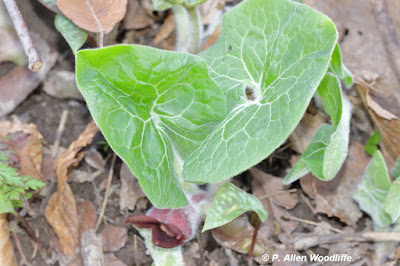There is no question that the current cooling of the weather has slowed the unfolding of spring, and that is the way it should be. Things, especially plants, were way ahead of themselves, and would risk a severe set back if they continued to develop and got hit with a significant frost in the next few weeks. It happens, as we have had snow even in the second week of May in recent years.
Nonetheless, there are still things to see and enjoy with a little bit of effort. I was at Rondeau earlier in the week, hoping to see the Black Vulture that treated birders on the last weekend. I spent a lot of time checking every vulture I could find, from the north end of the park to the south end. I saw black vultures, but not 'the' Black Vulture.
I also stopped at Mel's place, where the White-winged Dove that has graced the park with its presence over the last several years, is most apt to show up any day now. I didn't see any sign of the target species, but noted this next one on an adjacent lot. Rock Pigeons are not often seen in the park, as they are more often hanging around rural areas, especially farm yards.Given the bright sunny day, there were a couple of Carolina Wrens advertising their territory.
Yellow-bellied Sapsuckers are scattered far and wide in the park, but not always conducive for a good photograph.
Along one of the trails, this Northern Ribbon Snake was slithering by. It is a Species At Risk, and prefers swampy forest habitat, of which there is plenty at Rondeau. I am more likely to see them swimming on the water of a slough rather than through the leaves.
It looks a lot like an Eastern Garter Snake, but has more vivid black and yellow stripes, as well as a rusty brown stripe along the edge of the belly scales. Also it has a white dot right in front of the eye.
Wildflowers continue, such as Bloodroot.....
....and Spicebush, a shrub that is dominant especially in the damper areas of the park. In other words, it is almost everywhere!
This is a great time of year to explore Sinclair's Bush, about half way between Rondeau and Blenheim. Spring wildflowers are fairly diverse and abundant, but certainly are not at their peak quite yet.
Early Blue Cohosh is one of the earliest, and is out nicely right now.
The petals open up, and curl back, on bright sunny days, but on cloudy days, will almost close right up.
A much less conspicuous wild flower is Wild Ginger. Usually you just see the green leaves poking up through the dead leaves of last year......
....but if you pull away some of those dead leaves, you will see this flower that rests on the ground. It doesn't need to be seen by the flying pollinators that most plants attract, as this species is pollinated by beetles and ants, that spend most of their time at ground level.
Always a pleasant sight to see is Dutchman's Breeches.
Closer to home is the Thamesgrove Conservation area, along the Thames River at the east side of Chatham. The birds were not unusual, but I kept an eye open for flowering plants. I found Common Hackberry, a Carolinian tree species that is abundant along the river.
One of the highlights is to see the White Trout Lily in flower, a close relative to the Yellow one featured above. The white version is relatively uncommon in Chatham-Kent.
In other news, I got a new camera body to add to my equipment. It is the Canon EOS R6, a mirrorless full frame camera, which will also crop to 1.6X. With an adapter, I can use all of my existing lenses. It is a bit different than the two cameras I have had for several years, a Canon 5D3 and 7D2, and will require a bit of experimenting and adjustment to get comfortable with the new layout, features, etc. But so far it has been a relatively smooth adjustment. I haven't ventured into the more challenging photo situations that I do regularly with my other bodies, but have played around with it at home. Here are a few shots I've taken right from the kitchen window.
I'm looking forward to putting it through some more rigorous photography to see what it is really capable of. One of the things I am looking forward to trying out is low level photography. This camera has a tilt screen, so instead of lying on the ground, I can remain somewhat upright and tilt the screen to see the subject and get the right composition. As I become less and less able to kneel at a low level and get back up quickly and easily (a condition that many seniors eventually have to deal with :-), it will make low level photography less problematic, I hope.

























Thanks so much, LDB and sorry for the delayed reply. For some reason this blog site goes into a funk every so often, and when it does, I can't even reply to comments!
ReplyDeleteI'm glad you enjoyed the blog post. Hopefully it will add a bit of insight into the world of nature, which I have been privileged to work with and explore for a long time.
The warblers and many of the other passerines seem to be a bit slower in arriving compared to some years, but I expect (and certainly hope) that with the unsettled weather including a significant warming trend over the next few days, there might be quite a few new arrivals.